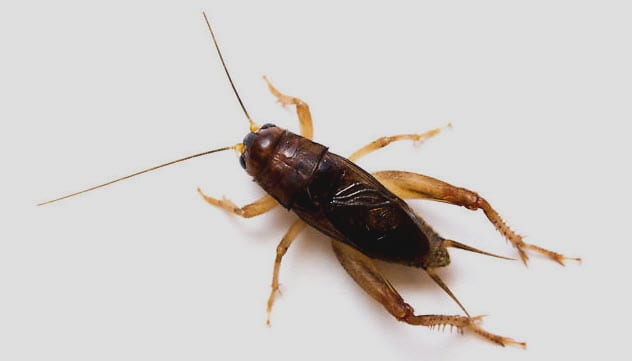We start off the new year with multiple science stories covering a variety of fields. We have some machine-on-machine violence and controversy surrounding the latest, high-tech female sex toy. Crows dazzle us with their intelligence, while crickets are apparently responsible for a Cuban “sonic attack.” We explore the science behind double-dipping and marvel at mysterious signals coming from outer space.
10 A Doping Scandal
A 90-year-old cyclist was stripped of his world record after failing a drug test. Back in July 2018, Carl Grove from Bristol, Indiana, took part in the US Masters Track National Championships. He won in the 90–94 age group, but this was not surprising as he was the only competitor. He also set a new world record. However, the United States Anti-Doping Agency (USADA) stripped him of his record after the cyclist received two doping violations. Grove submitted a sample the day of the competition on July 11, and it tested positive for epitrenbolone. He was also using a supplement found to be contaminated with clomiphene. However, another sample that Grove submitted the day prior had no traces of prohibited substances. It seems that the USADA is inclined to believe the cyclist’s excuse that the drugs “more likely than not” came from tainted cow liver he ate the night before the race. Grove has only been issued a public warning but will have to race again if he wants his record back.[1]
9 An Expensive Fish
A massive bluefin tuna sold for a record 333.6 million yen ($3.1 million) at a New Year’s auction in Tokyo. The fish weighed in at 278 kilograms (612 lbs) and was bought by Kiyoshi Kimura, the self-proclaimed “Tuna King” who owns a chain of sushi restaurants. The sale took place at a special auction commemorating the closing of the renowned Tsukiji fish market, which was among the largest seafood markets in the world. It closed last year to make room for parking for the 2020 Tokyo Olympics and moved to the new Toyosu facility. Kimura expressed some buyer’s remorse after the auction. He expected the fish to go for 30–60 million yen, but he ended up paying over five times that. The Tuna King’s purchase doubled the previous record of 155 million yen which was set at the 2013 New Year’s auction. There was also a lot of pride involved in the sale. Kimura had paid the top price for a fish at six consecutive New Year’s auctions until last year when another businessman outbid him. This year, Kimura made sure that he took back the title.[2]
8 An Unexpected Comeback
Axl Rose has released his first new song in over a decade, and he did it in a Looney Tunes cartoon. Back in the ’90s, Guns N’ Roses was among the most popular music groups in the world. However, tensions between band members caused a long recording hiatus following the release of their 1993 album, The Spaghetti Incident? It took another 15 years for Guns N’ Roses to release their next album, Chinese Democracy, to a lukewarm reception. This caused front man Axl Rose to go on another long hiatus. During that period, he still toured, regrouped with the band’s classic lineup, and even performed as AC/DC’s new lead singer. But he didn’t record any new material. That changed recently when he released “Rock the Rock.”[3] The music video features Axl in animated form alongside Bugs Bunny and other Looney Tunes characters rocking out in an effort to stop an asteroid. The video itself is a snippet from an upcoming New Looney Tunes episode.
7 A Daft Mistake
Scholars from the British Museum admitted to being “daft” after realizing that an artifact they had been displaying as an ancient vase was actually the head of a mace turned upside down. Until the end of the month, the British Museum is showcasing an exhibition titled No Man’s Land. It presents objects which tell the story of the first border conflict on record between the Sumerian cities of Lagash and Umma during the third millennium BC. However, while researching the exhibit, curators discovered that one of their artifacts was not what they thought at all. One of their “vases” actually turned out to be a weapon placed upside down. Scholars realized their blunder after comparing their object with a similar one at Yale University. The artifact was actually the head of a mace or club which was made for King Gishakidu of Umma. Now that it’s right-side up, the decoration on it makes a bit more sense. It is a depiction of a net which was used to immobilize people for execution.[4]
6 A Fallen Robot
A unique motoring accident took place on the streets of Las Vegas. Camera footage shows a “self-driving” car committing a hit-and-run on a robot. The sheer bizarreness of the event plus the fact that the city is currently hosting CES 2019, the largest electronics trade show in the world, has people skeptical of the video’s authenticity. In fact, most have labeled it a publicity stunt. They are probably correct, although nothing is official just yet.[5] The robot is named Promobot and is the creation of a Russian company also called Promobot. It was run down by a Tesla Model S. The Russian organization wasted no time in milking the “accident” for maximum exposure. Spokespeople for Promobot have given interviews and a press release mourning their fallen comrade. As of this writing, neither Promobot nor Tesla has commented on the alleged hoax.
5 A Sonic Conundrum
Over the last few years, multiple US diplomats and their family members residing at the US embassy in Cuba have complained of strange noises. These brought on a number of symptoms such as vertigo, dizziness, and ringing in the ears. US officials feared they were being targeted by a “sonic attack,” but new research suggests that the bizarre noises were just crickets. The problem started in 2016. In late 2017, an audio sample of the sound was first released to the public. It has been described as “piercing squeals” and “grinding metal.” However, people were unable to identify the source of the noise. As expected, Cuban officials have vehemently denied orchestrating any kind of “sonic attack” on their American counterparts. Two scientists from the University of California, Berkeley, and the University of Lincoln in England claim that the sound is caused by the Indies short-tailed cricket. They have analyzed the audio sample, and multiple characteristics such as oscillations per pulse, repetition rate, power spectrum, and duration match the insect’s chirps. There are some inconsistencies between the two which the researchers blame on the fact that the recording was made indoors while the crickets were outside. The study has not been peer-reviewed yet, so it is far from a closed case. Moreover, the two scientists are stating that just the noises were made by crickets. They aren’t discounting the possibility that embassy personnel were also the victims of an attack or that their symptoms were psychosomatic.[6]
4 A Contentious Sex Toy
There is more controversy from the Consumer Electronics Show (CES). The organizers have been accused of gender bias after banning a female sex toy even though sex technology aimed at men has been showcased in the past. The Ose personal massager is a hands-free device which uses micro-robotic technology to mimic the sensations of a human tongue and fingers. It was developed by Oregon start-up Lora DiCarlo. More than just being presented at CES, the gadget was initially selected as the CES 2019 Innovation Awards honoree in the Robotics and Drone category. The company’s celebration was short-lived. Organizers contacted Lora DiCarlo with bad news: Not only were they not receiving an award anymore, but they would not even be allowed to exhibit the Ose massager at CES 2019. They organizers claimed that the device is not eligible for an award because it doesn’t fit into any existing product categories. It also cannot be showcased because it was deemed by the Consumer Technology Association to be “immoral, obscene, indecent, profane or not in keeping with CTA’s image.”[7] Lora DiCarlo founder Lora Haddock pointed out that Ose was developed in partnership with the robotics lab of Oregon State University and has eight pending patents encompassing robotics, biomimicry, and engineering. Therefore, it clearly fits in the Robotics and Drone category. As far as the device being obscene, Haddock also observed that VR porn is a staple of CES and that a sex robot named Solana debuted at last year’s trade show with no objections.
3 A Smart Bird
We all know that crows are really intelligent animals. But the birds have recently been observed exhibiting an ability previously only ascribed to humans—they can infer the weight of an object by how it moves in the wind. If there are several items on a table and a breeze blows some of them away, we understand that those are lighter than the items which stood still. According to a study conducted at the University of Cambridge, apparently, so do New Caledonian crows.[8] During the experiment, researchers trained 12 birds to discriminate between light and heavy objects. Half of them were rewarded when they dropped light items into a food dispenser, while the other half had to drop heavy objects. After this initial phase, the crows were then presented with new items they had never seen before. These were suspended from strings and placed in front of an electric fan so that the birds could see how they swayed in the wind. Finally, the crows were allowed to make a choice between the two objects. The birds selected the object that would earn them a reward in 73 percent of cases. With the fan turned off, they did no better than chance. While this seems to indicate that crows can infer weight, this experiment has never been performed with other animals. So we don’t know how widespread the ability is. Study lead author Sarah Jelbert would like to see it run again with primates.
2 A Double-Dipped Chip
Most people have probably double-dipped at some point. That’s when you dip a chip, take a bite, and then dip again. But have they been exposing the individuals around them to large amounts of bacteria? A new experiment says “yes.” Food scientists Paul Dawson and Brian Sheldon have recently published a book titled Did You Just Eat That? It looks at the most common ideas about food safety to see if there is any science to back them up. Double-dipping is a concept that has been around for a while, but it was popularized in an episode of Seinfeld. According to one character, double-dipping is “like putting your whole mouth right in the dip.” For their experiment, researchers dipped and double-dipped chips in chocolate sauce, cheese dip, and salsa. Then they checked the amount of bacteria transfer. Professor Dawson admitted that he didn’t expect to see much difference due to the small surface size of the chip.[9] However, there were actually around 1,000 more bacteria per milliliter of dip in the case of double-dipping. Dawson called this a “significant amount” which was more similar to person-to-person transfers of contagious diseases than regular foodborne maladies. The researchers also tested the five-second rule. It says that if you drop food on the floor, it is still safe to eat if you pick it up within five seconds. Dawson called this a game of “Russian roulette” as it is the type of surface that truly matters, not the duration. Carpet turned out to be better than tiles or a wooden floor as carpet actually soaked up the salmonella used in the experiment.
1 A Mysterious Signal
Astronomers from Canada have detected puzzling space signals coming from a distant galaxy. These kinds of signals are known as fast radio bursts (FRBs), and they only last a few milliseconds on average. In this case, the repeating radio waves picked up by the CHIME telescope in British Columbia emanated from the same source located about 1.5 billion light-years away. Astronomers made the discovery last year and now have published their findings in Nature. Although dozens of single FRBs have been detected, this is only the second time that we have spotted a repeating FRB. While we don’t know the exact origin of the radio signals, scientists do have a few ideas. They think it could be two neutron stars colliding with each other or just one neutron star rapidly spinning in a region with a high magnetic field. There are also several hypotheses implicating black holes. They are either collapsing, devouring a neutron star, or being hit by dark matter.[10] Of course, there has also been talk that it could be aliens. Harvard astrophysicist Avi Loeb believes that FRBs could come from energy beams used to propel spacecraft. Even skeptics like Duncan Lorimer, the scientist who discovered the first FRB in 2007, can’t rule out the possibility. However, he thinks a magnetized neutron star is more plausible.
























